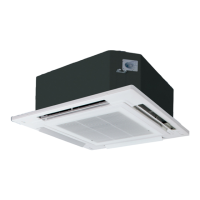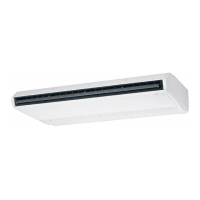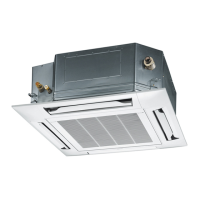55
10.5.5. Transporting and installing the outdoor unit
• Transporting
1. The outdoor unit should be transported in its original packaging as close to the installation location as possible.
2. If suspending the outdoor unit, use a rope or belt, and use cloth or wood as padding in order to avoid damaging the unit.
• Installation
1. Read the “Selecting the outdoor unit installation location” section thoroughly before installing the outdoor unit.
2. If installing the unit to a concrete base or other solid base, use M10 or W3/8 bolts and nuts to secure the unit, and ensure
that the unit is fully upright and level.
(The anchor bolt positions are shown in the diagram at the right side.)
In particular, install the unit at a distance from the neighbouring building which conforms to regulations specified by local
noise emission regulation standards.
3. Do not install the outdoor unit to the building’s roof.
4. If there is a possibility that vibration may be transmitted to the rooms of the building, place rubber insulation between the
unit and the installation surface.
5. Drain water will be discharged from the outdoor unit when operating the system in heating or defrosting modes. Select an
installation location which will allow the water to drain away properly, or provide a drainage channel so that the water can
drain away.
(If this is not done, the drain water may freeze during winter, or the water may spill down to areas underneath the installa-
tion location.)
• If a drain pipe needs to be installed, insert the accessory drain elbow into the mounting hole at the bottom of the outdoor unit, and
connect a hose with an inside diameter of 15mm to this drain elbow.
(The hose is not supplied.)
If using the drain elbow, install the outdoor unit on a base which is at least 5cm high.
10.5.6. Connecting the pipes
• Use a clean pipe which does not include water or dust for inside of piping.
• When cutting the refrigerant pipes, a piping cutter must be used. Before connecting the refrigerant pipes, blow nitrogen and blow
off dust in the pipes.
(Never use tools which cause a lot of dust such as a saw and a magnet.)
• When waxing replace nitrogen inside the piping after removing dirt and dust. (In order to prevent oxidation scale from forming
inside the piping).
• The refrigerant pipes are of particular importance.
The installation work for refrigerant cycles in separate-type air conditioners must be carried out perfectly.
1. Refer to the table below for the pipe diameters equivalent lengths and indoor/outdoor unit difference of elevation.
NOTE In cold regions (where the outdoor air temperature can drop to 0°C or below continuously for 2-3 days), the drain water may freeze,
and this may prevent the fan from operating. Do not use the drain elbow in such cases.
Model Pipe diameter (mm) Equivalent length (m) Difference of elevation (m)
Liquid-side pipes Gas-side pipes
1.5 HP • 2 HP ø6.35 x t0.8 ø12.7 x t0.8 30 20
2.5 HP ~ 6 HP ø9.52 x t0.8 ø15.88 x t1.0 50 30

